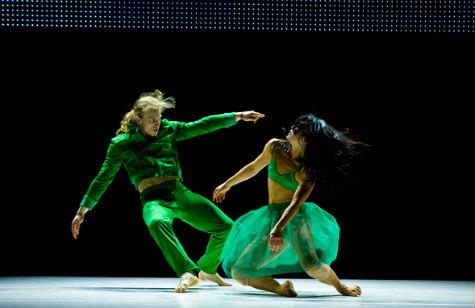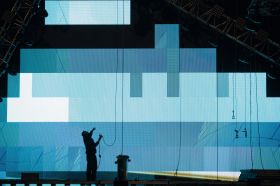As the ominous reverberations of the electrically charged soundtrack composed by Luke Smiles’ bellows over the stage, the intensity of the atmosphere is set.
A video screen provides the backdrop of illumination, complementing the lighting that floods the room with a potent almost toxic shade of colour. The stage glows with transcendent light. G is for green.
Figures slowly emerge one by one, crossing the stage from left to right. They pass first in an eerie suspended state, as if sleepwalking without volition. As the tempo increases the dancers switch to whizzing sideways across the stage with dizzying speed. The incredible fitness of the performers is showcased as they lap the stage one after the other. G is for giddy.
As the momentum increases the performers erupt into a series of increasingly bizarre and erratic movements highlighting the madness montage from the original ballet Giselle. This production’s deconstruction of the romantic nineteenth century classic portrays Giselle’s tragic tale as a descent into hysteria with overtly sexual overtones, where the male and female performers strive to incorporate elements of expression in their movements that are suggestive of metaphysical states. G is for gyrate.
As the drama unfolds into what would be the second act of Giselle, the brightly lit up video screen behind the stage narrates the events unfolding by fading in disjunctive sentences. The movements become even more distorted, exhibiting the strength and agility of the incredibly talented performers. The dancers contort their limbs into maniacal forms as this crazed interpretation of embodied vulnerability manifests into spasms of the disturbingly unnatural. G is for ghastly.
The choreography of G is revolutionary in its powerful interpretation of traditional dance pieces. The style combines elements of ballet and contemporary with a distinctly avant-garde construction. The audience is catapulted in between scenes of extreme physicality in one moment to the next where dancers dangle precipitously in stances of supreme sublimation. In rehearsing for this production, the dancers would undergo training in gymnastics, yoga, meditation and cardio and this expansive range of skills is exhibited and fully utilised by the choreographer. G is for Garry Stewart.
The idea for the overriding theme in this production was derived from Steve Wainwright’s essay Giselle, Madness and Death. In this essay the ballet piece is used as a case study to examine prevailing notions of hysteria. The essay explores how diagnosis of such a condition was designed to stereotype and subjugate women of the era. The analysis is an interesting one with Stewart’s modern day interpretation of Giselle comparing how concepts such as sexualisation and experimentation go to show how irrelevant prevailing ideas of pathology at the time have now become. G is for genesis.
G will be a shocking experience for some. The deranged depictions of the characters and erratic designation of roles make the action difficult to digest. The narrative of the dance is splintered, with various scenes simply sliding across the stage lacking continuity. Regardless, the dedication of the performers to their parts is admirable. Kimball Wong gives an outstanding performance of an incredibly difficult piece of choreography that is amazing to watch. G is for goodness gracious!
G opened to rapturous applause at Sydney Theatre in Walsh Bay on 16 May. It was the first performance of a production that Stewart has been continually building upon since 2008 and has received worldwide support from theatre companies as far wide as the Theatre de la Ville in Paris. The piece pushes the boundaries of modern dance techniques and forces us to consider the juxtaposition of modern notions of sexuality against the countervailing repressive tactics used in the past. All of this is indicates that dance, like the rest of society, has come a long way in the past few centuries. G is for Giselle.
Rating: 3 stars





